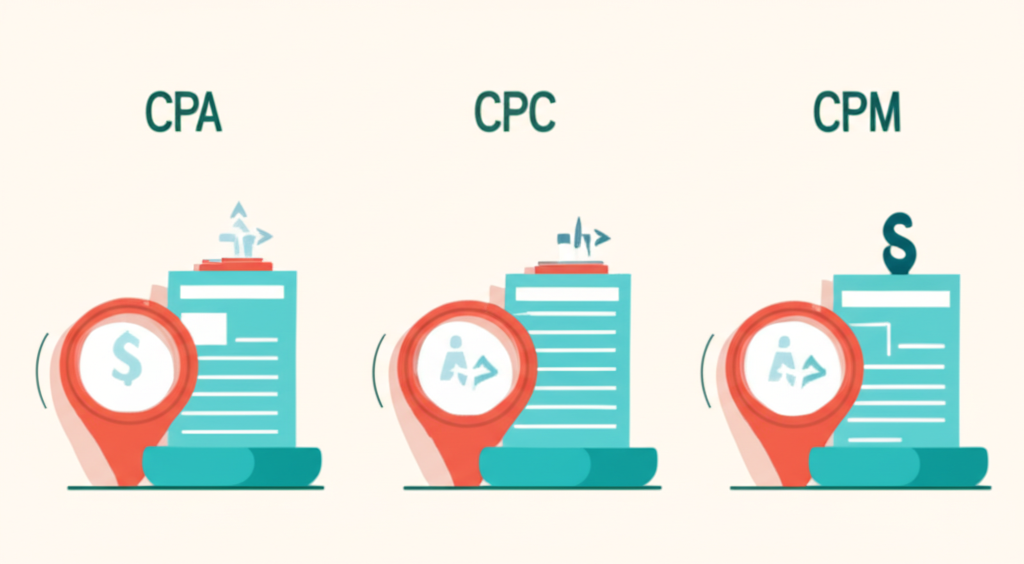Unlocking CPA Marketing Success: Proven Tactics for Profit

Understanding CPA Marketing: Risk, Reward, and ROI
Cost-per-action (CPA) marketing has become the gold standard for performance-driven advertisers. Unlike CPC (cost per click) or CPM (cost per mille/impressions), CPA shifts the financial risk from advertiser to publisher. You only pay when a desired action—be it a sale, signup, or download—is completed. This model aligns incentives, pushing publishers to deliver quality traffic and real conversions rather than vanity metrics.
When you examine the ROI dynamics, CPA offers a far more predictable bottom line. Imagine paying a fixed fee for each qualified lead instead of gambling on every click or impression. Your budgets become razor-sharp, eliminating wasted spend on unqualified traffic. This infographic breaks down the nuances:
- CPA: Payment on confirmed action (e.g., form submission, purchase). High alignment, low risk for advertisers.
- CPC: Payment on click, regardless of outcome. Moderate alignment, moderate risk.
- CPM: Payment on impressions. Broad reach, high risk when it comes to conversion.
One of the most compelling benefits of CPA marketing is its transparency. You can trace every dollar spent directly to completed goals, making it easier to scale winning campaigns and cut underperforming ones. For affiliates and publishers, CPA pushes you to optimize creative, landing pages, and traffic sources continuously. If you thrive on data, experimentation, and iterative improvement, CPA marketing is your playground.

Top CPA Offer Types and How to Leverage Them
Knowing the right offer types is crucial. CPA marketing isn’t one-size-fits-all; it’s a spectrum of verticals and actions. Here are the heavyweight categories and proven tactics to maximize each:
Cost-Per-Lead (CPL)
CPL offers reward you for capturing prospect data—email, phone number, or survey response. To succeed, craft a razor-focused lead magnet: whitepapers, exclusive webinars, and discount codes work like magic. A/B test headlines, form fields, and call-to-action buttons to squeeze every percentage point out of your conversion rate.
Cost-Per-Sale (CPS)
CPS, also known as revenue share, pays only when a purchase is completed. Ideal for e-commerce affiliates, this model demands persuasive copy, social proof, and seamless checkout flows. Leverage upsells and order bumps to increase average order value. Integrate exit-intent popups with limited-time discount codes to recapture abandoning shoppers.
Cost-Per-Download (CPD) & Cost-Per-Install (CPI)
CPD and CPI offers tap into software trials, app installations, and digital tools. Optimize your mobile creative—bright colors, clear buttons, and concise benefits. For desktop downloads, highlight free trials, fast setup, and no-risk guarantees. In both cases, track device types, OS versions, and user demographics to refine targeting.
Hybrid CPL + CPS Models
Some networks offer hybrid models combining lead capture and sale commissions. This can hedge your risks and boost overall revenue. Use multi-step funnels: first gather a lead, then upsell a premium version. Your initial CPL revenue cushions the cost of leads that don’t convert on the backend sale.

Audience Segmentation Strategies for Maximum Conversions
Even the best CPA offers will stumble without targeted traffic. Audience segmentation allows you to tailor messaging down to the individual user level. Here are three powerful clustering techniques:
1. Demographic Profiles
Break your market into age, gender, income, and location segments. A fitness supplement ad targeting men aged 25–34 in urban areas will perform differently from one aimed at women 45–54. Use demographic insights from native ad platforms, Facebook Ads, and Google Ads to sculpt precise ad sets.
2. Behavioral Targeting
Interest- and behavior-based targeting taps into past online activity: pages visited, videos watched, or products viewed. A user who spent time on vegan recipe blogs is more likely to convert on a plant-based supplement offer. Leverage retargeting pixels and audience pools to stay top-of-mind and nudge users down the funnel.
3. Lookalike Audiences
Lookalikes are your secret weapon for scaling winners. By feeding successful lead or customer lists into ad platforms, you can unearth fresh prospects with near-identical behavioral patterns. Continually update and prune your seed lists to maintain high relevance and low cost per acquisition.
Combining these segmentation layers yields hyper-targeted campaigns. For instance, serve different landing page creatives to male vs. female audiences. Test copy variations that speak directly to the unique pain points of each group. The result? Higher relevance scores, reduced ad costs, and skyrocketing CPA performance.

Leveraging AI for CPA Automation and Optimization
Artificial intelligence is no longer futuristic—it’s an everyday necessity in high-stakes CPA campaigns. AI-driven tools can handle bid management, creative testing, and real-time lead qualification at scale:
Predictive Bid Adjustment
Machine learning models analyze historical performance data to predict which ad placements and times yield the lowest CPA. Automated bid managers allocate budget dynamically across channels—search, social, native—maximizing ROI while hitting daily spend targets.
Dynamic Creative Optimization (DCO)
DCO platforms rotate headlines, images, and CTAs on the fly. By continuously testing variations, AI isolates the highest-performing creative combination for each audience segment. This real-time learning loop dramatically reduces manual split-testing workloads.
Chatbots for Lead Qualification
Integrate AI-powered chatbots on your landing pages to pre-qualify traffic. Chatbots engage users instantly, ask qualifying questions, and funnel only the most promising leads through to your CPL offers. This reduces downstream drop-off and inflates your conversion and payout rates.
When combined, these AI tactics free you from manual guesswork. You can focus on strategic expansion—exploring new verticals, refining angles, and scaling budgets—confident that your campaigns self-optimize for peak profitability.
Conclusion: Your Roadmap to CPA Mastery
CPA marketing success hinges on four pillars: mastering cost-per-action models, selecting the right offers, pinpointing high-value audiences, and embracing AI automation. Start by mapping your goals—leads, sales, or installs—and choose the CPA structure that aligns with your risk tolerance. Build tailored funnels for each offer type, then layer in segmentation to speak directly to every user’s motivations.
Finally, integrate AI tools to handle bidding, creative testing, and qualification in real time. This synergy of data-driven tactics and machine-powered efficiency will slash your CPAs, boost ROI, and leave competitors scrambling to catch up. The future of performance marketing belongs to those who can unlock the full potential of CPA. Will you be one of them?









